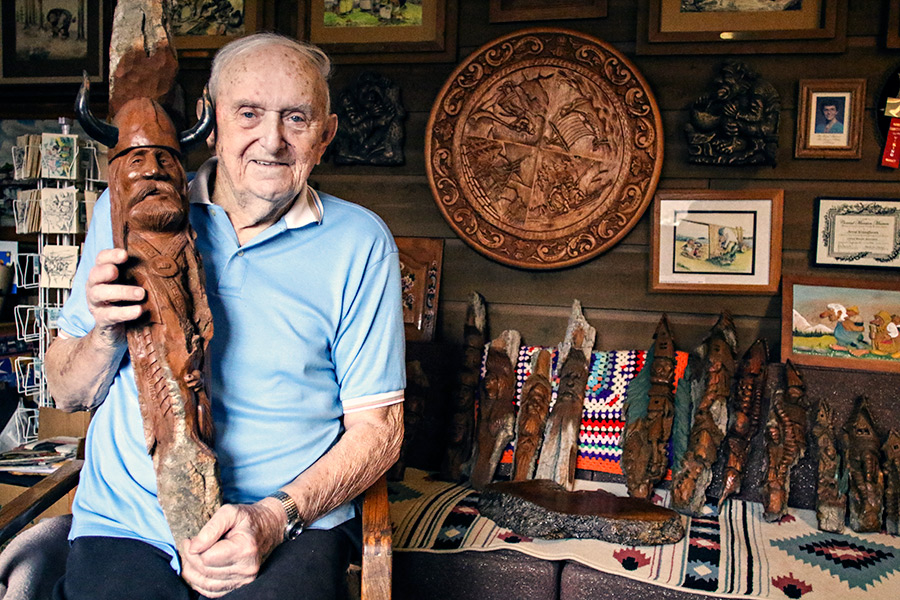When Arvid “Chris” Kristoffersen was a 14-year-old boy in Norway, the Nazis had taken over his country in the midst of World War II, and he and his family were hungry.
It was 1944, and Norway had been under heavy rations on most all food items for nearly five years.
“The only thing you had on your mind was to survive,” he said last week from his Kalispell home’s basement, his words still heavy with a Norwegian accent.
He and his friends Thor and Gustav screwed their courage to the sticking place and decided to raid a German warehouse full of food for the invading soldiers. Kristoffersen had just gotten his hands on a ham and a couple of two-foot salamis, having already wrapped a string of sausages around his neck, when their presence was noticed.
“I made an Olympic time running away,” he said, laughing.
The boys ran for the nearby hole they’d made in the barbed wire to escape, with Kristoffersen the last to scoot under. As he was jumping down a Nazi soldier ran at him, bayonetting his leg, as machine gun fire flew overhead.
Using what he had, Kristoffersen made a stand.
“I knocked him out by hitting him in the face with a 20-pound ham,” he said.
The ham leg had a strap he had wrapped around his wrist, so he hung onto it, two of the salamis stuck in his shirt, and two dozen or so of the German sausages around his neck.
When dawn came, there was talk about the wieners stuck on the barbed wire fence at the German warehouse, and Kristoffersen’s doctor said he was lucky the three-inch wound didn’t knick a nearby artery.
This story and others like it are now the focus of Kristoffersen’s artistic efforts. Hailed as the No. 2 fairytale artist in Norway, Kristoffersen, a longtime Flathead Valley resident, is known for his paintings and carvings, especially his series of what he calls “Happy Trolls,” following the silly forest creatures in lives less scary than their traditional counterparts. A series of three books recently came out chronicling essential Norwegian artists from the Iron Age to present time, and Kristoffersen is in the third.
Kristoffersen, 87, will make a rare appearance at a local art show, with plans to have a table of art at the upcoming Artists and Craftsmen of the Flathead show at the Flathead County Fairgrounds, Nov. 25-27. The booth will offer prints of his famous illustrations, and a chance to talk to a legend in the field.
He’ll be recognizable by the horned helmet with blond braids he’ll be wearing, which garnered about 200 photos with people at the Norsk Høstfest in Minot, North Dakota.
Kristoffersen’s paintings of American Indian culture and early cowboys used to cover all four floors of the Havre Courthouse rotunda until a renovation covered them up, and in the 1960s, he artistically restored the Conrad Mansion, which at the time was slowly coming apart. The ceiling had gotten wet and was falling down, so Kristoffersen was tasked with repainting and replacing the original art and carvings.
The renovations were such a success that Kristoffersen was asked to do the same for Sam Bibler’s house by Foy’s Lake, now the site of the Bibler Home and Gardens.
Kristoffersen is also responsible for the art in the Fargo-Moorhead Sons of Norway Kringen Lodge, in which he painted murals on 90 feet of walls, then added more than 20 intricately carved, large trolls. He carved the Viking ship on the outside and painted the flowers in the conference room. His work there earned him and his wife an invitation to breakfast with the Norwegian princess.
These days, Kristoffersen’s artistic leanings are more of the written kind as he works on a memoir about his time in occupied Norway, what he is calling “Incredible Years,” chronicling 1940-1945. Weekly creative writing classes at Flathead Valley Community College spurred the project, and each story comes with illustrations.
He remembers a Russian prisoner-of-war camp stationed near where he and his blacksmith father had been hired to fashion parts for the Nazis as they drilled into the mountainside to build bunkers. The Russians were marched to the top of a mountain in the winter, with only used, empty cement sacks with holes cut out for eyes as their protection from the cold, along with ratty blankets wrapped around their legs. They were fed rotten food, from vegetables to fish heads, and Kristoffersen remembers passing along slices of bread to them whenever he could without attracting Nazi ire on himself.
Before that, he was working in a bakery when the Germans invaded. The Nazis took over the bakery to make bread for the German soldiers. Kristoffersen was allowed to keep working there, and he was in charge of bringing wooden planks of freshly baked bread to the storeroom. When his requests for extra food were rejected, he opened the storeroom window and threw bread loaves out, hiding them in the weeds until he could pick them up.
Kristoffersen moved to the Flathead Valley in 1952, to work on his aunt’s — a member of the Tutvedt family — farm, where soon after he was drafted and became an Army engineer. He moved to Havre for 10 years, drawn there to work on the courthouse. After a six-year marriage ended, Kristoffersen moved back to the Flathead. He and Roslyn met in 1983, and were married in 1984. Roslyn, 86, still teaches dance lessons at FVCC.
When asked why he decided to make an appearance at the show, Kristoffersen shrugged and smiled in his basement art studio, which he calls his “hideaway.”
“I’m living here, so I want to show people what I’m doing,” he said.
